As the FAWSL gets back underway, there are several prominent names that are looking to make their mark at the highest level of the Women’s game in England. One of the more notable moves in the most recent transfer window is 33-year-old Welsh international Jess Fishlock joining Reading FC on loan from NWSL side OL Reign. Fishlock brings a wealth of experience with her to Reading as she has been well traveled in her career, featuring stints in The United States, Germany, France and Australia.
In this tactical analysis we will look at the tactical strengths that Fishlock brings to the table. Both in attack and defence, before studying her statistics from previous stints and thus far in the FAWSL to determine her strengths and weaknesses, as well as how she fits into Reading’s tactical setup..
In Attack
As one of the most prominent signings in the summer transfer window, there is no doubt that Fishlock brings heavy expectations with her to Reading. Best known for her ability on the ball in possession and on attack, we will examine this part of her game first.
One of Fishlock’s best qualities in the midfield is her ability to both find and receive the ball in space. As shown below, Fishlock is adept at receiving the ball in between her opposition’s defensive lines.
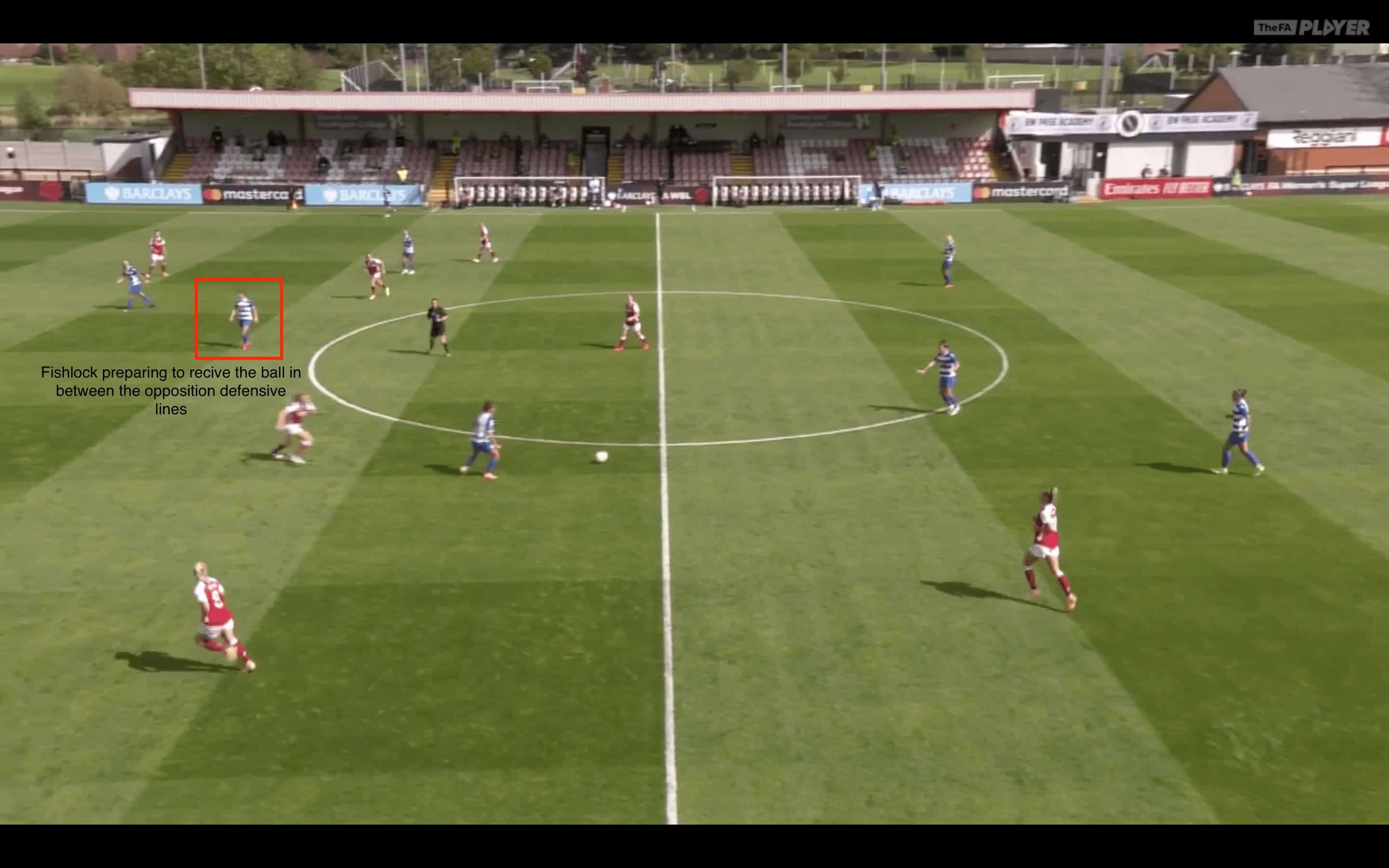

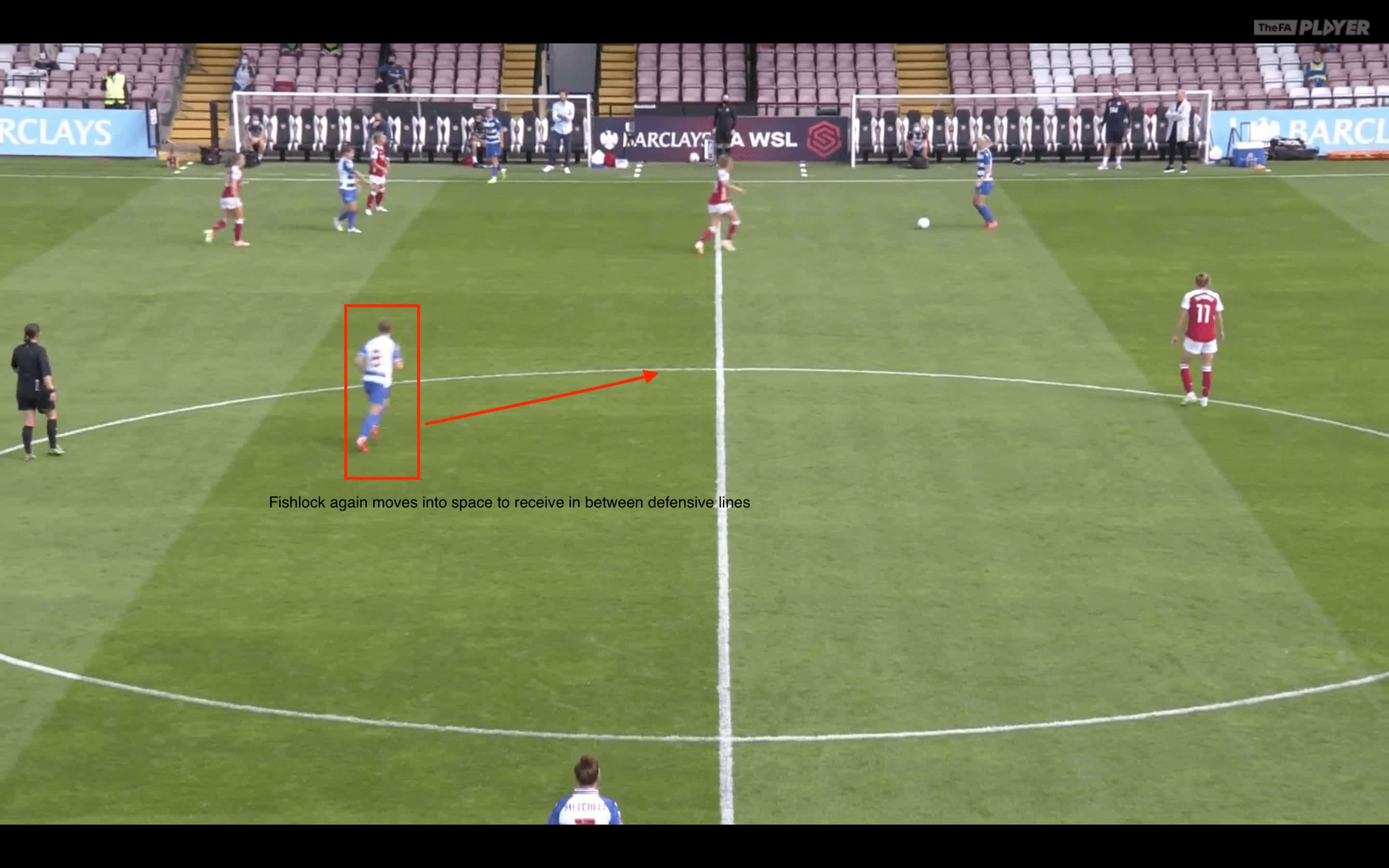
By receiving the ball in between the opposition’s defensive lines, Fishlock is able to both receive the ball in space and simultaneously ask questions of her opponents defenders. As she receives the ball in these areas, defenders must decide whether to put pressure on Fishlock or to stay with their original marks. By receiving the ball in these areas, Fishlock enables her side to break down opponents by pulling them out of position and creating attacking overloads.
By doing so, Fishlock enables her side to be dangerous in the attack and helps create multiple attacking options based on how her opposition reacts to her movement. Fishlock also excels in her ball reception in possession. One of the keys to this for her is receiving the ball facing forward as well as adjusting her body to receive the ball side on. This enables her to be more dangerous in possession as she does not have to turn to beat opponents and can scan the opponent’s defense for weaknesses before even receiving the ball. There are a few examples below.
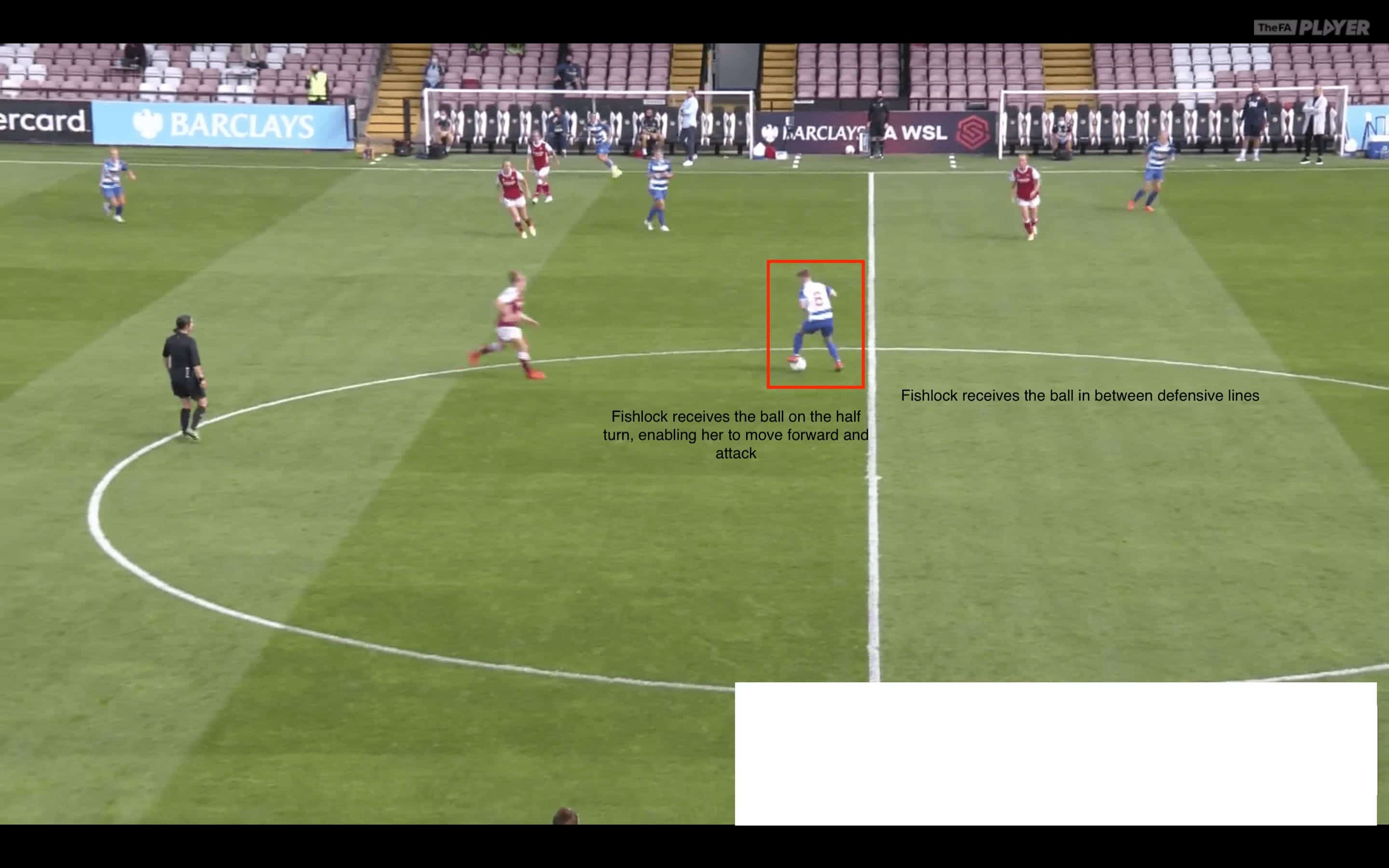
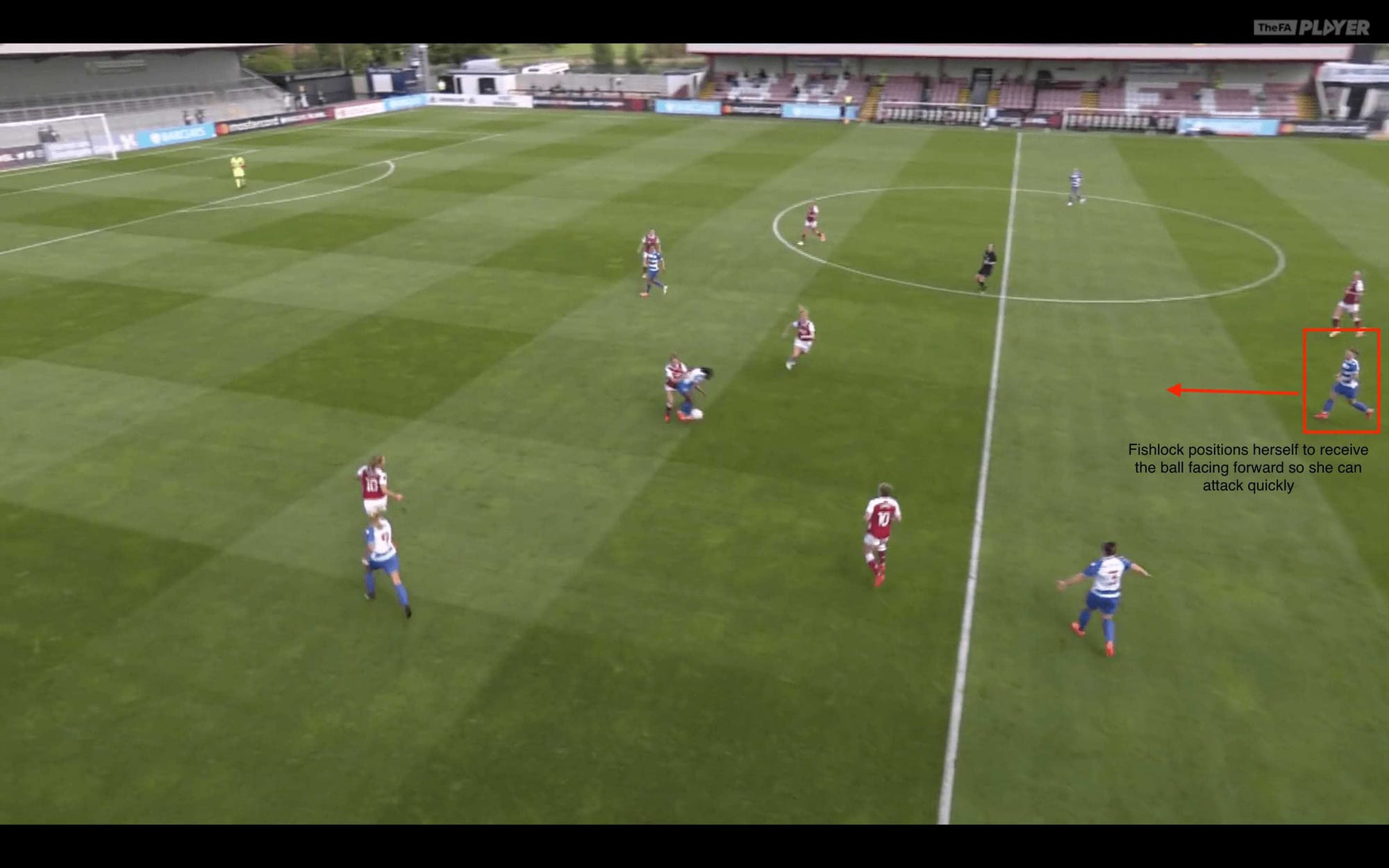
The next part of Fishlock’s game in the attack for us to analyse is her passing proficiency. Since she often receives the ball in space due to her exceptional spatial awareness and understanding as mentioned above, Fishlock is often faced with opportunities to pass the ball to her teammates to either keep possession or penetrate the opposition’s defence. Fishlock is among the most accurate passers in the world and excels in passing the ball in both medium and long range distances. She also possesses the ability to accurately and effectively play the ball through defensive lines and play forward, progressive passes. Thus, she is a good fit for Reading’s attacking setup as she often receives the ball with multiple options to both move the ball from side to side, as well as penetrate the opposition with a forward pass.
Not to be out done by her ability in possession, Fishlock is also a rare talent in the final third. This is best exemplified by her assist total versus her expected assist (xA) totals in her last 28 matches in the NWSL. In her last 28 matches before her move to Reading, her xA total was 2.4. However, in those 28 games, she slightly outperformed her xA by amounting three assists in that time span. In addition to this, Fishlock has also proven that she is capable of being on the finishing end of things herself. In those same 28 matches, Fishlock’s expected goals (xG) was 7.0. She again outperformed the data by amassing eight goals in the final 28 matches of her NWSL career. These statistics show that Fishlock is talented at both finding the final pass, as well as finishing her opportunities in the final third, thus making her a valuable asset in any attack.
In defence
While Fishlock is rightfully recognised for her ability in the attack and in possession, one of the more underrated parts of Fishlock’s game is her ability on the defensive side. Obviously, defending is an important part of every system and the Reading 4-3-3 system is no exception. Due to Reading’s high pressing tactical setup, and the expansive nature of Reading’s fullbacks in possession, there is quite a lot asked of the three midfielders in Reading’s lineup. Fishlock fits the bill very well for Reading for several reasons. Firstly, let’s take a look at her ability to provide an effective cover shadow in Reading’s press.
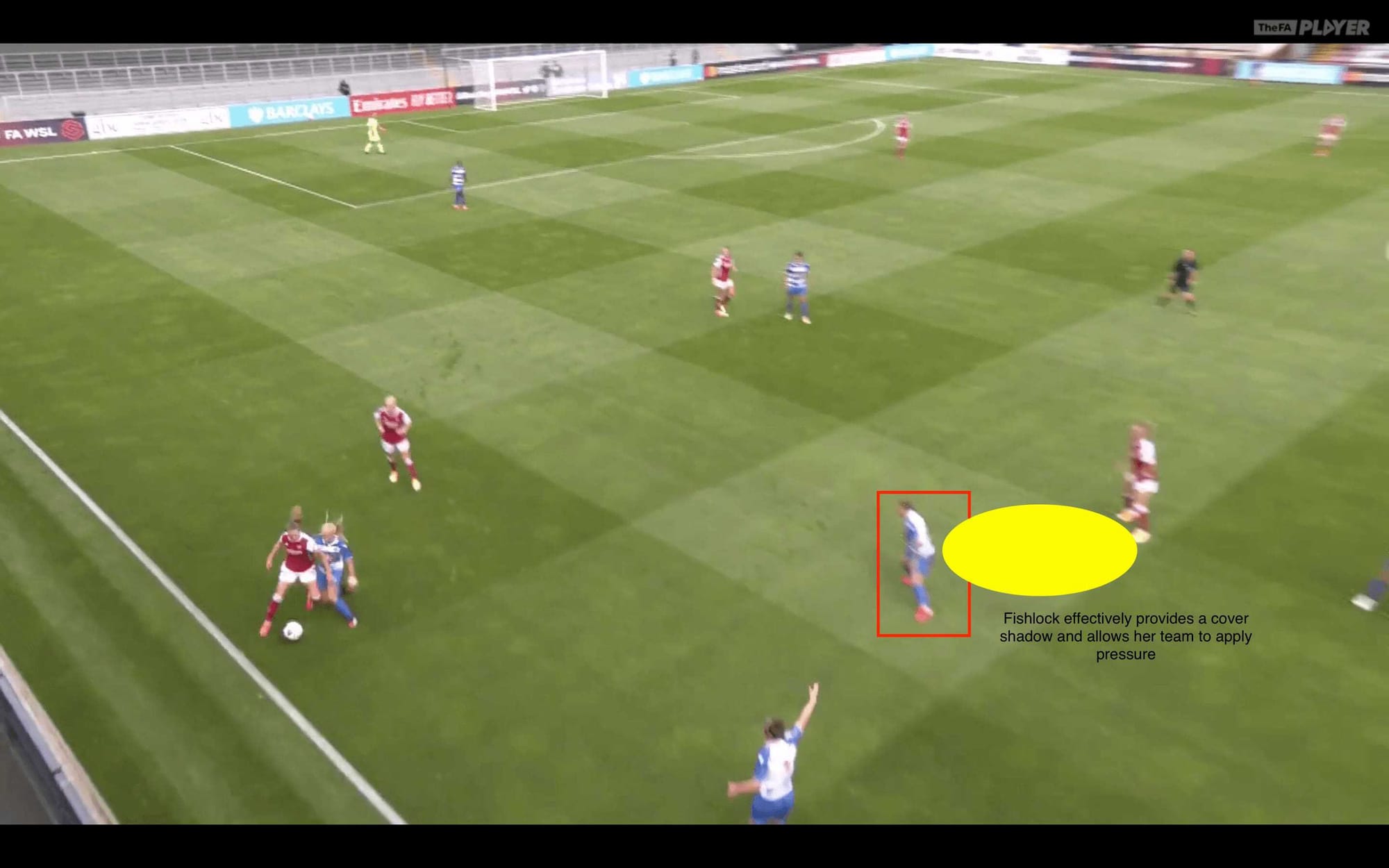
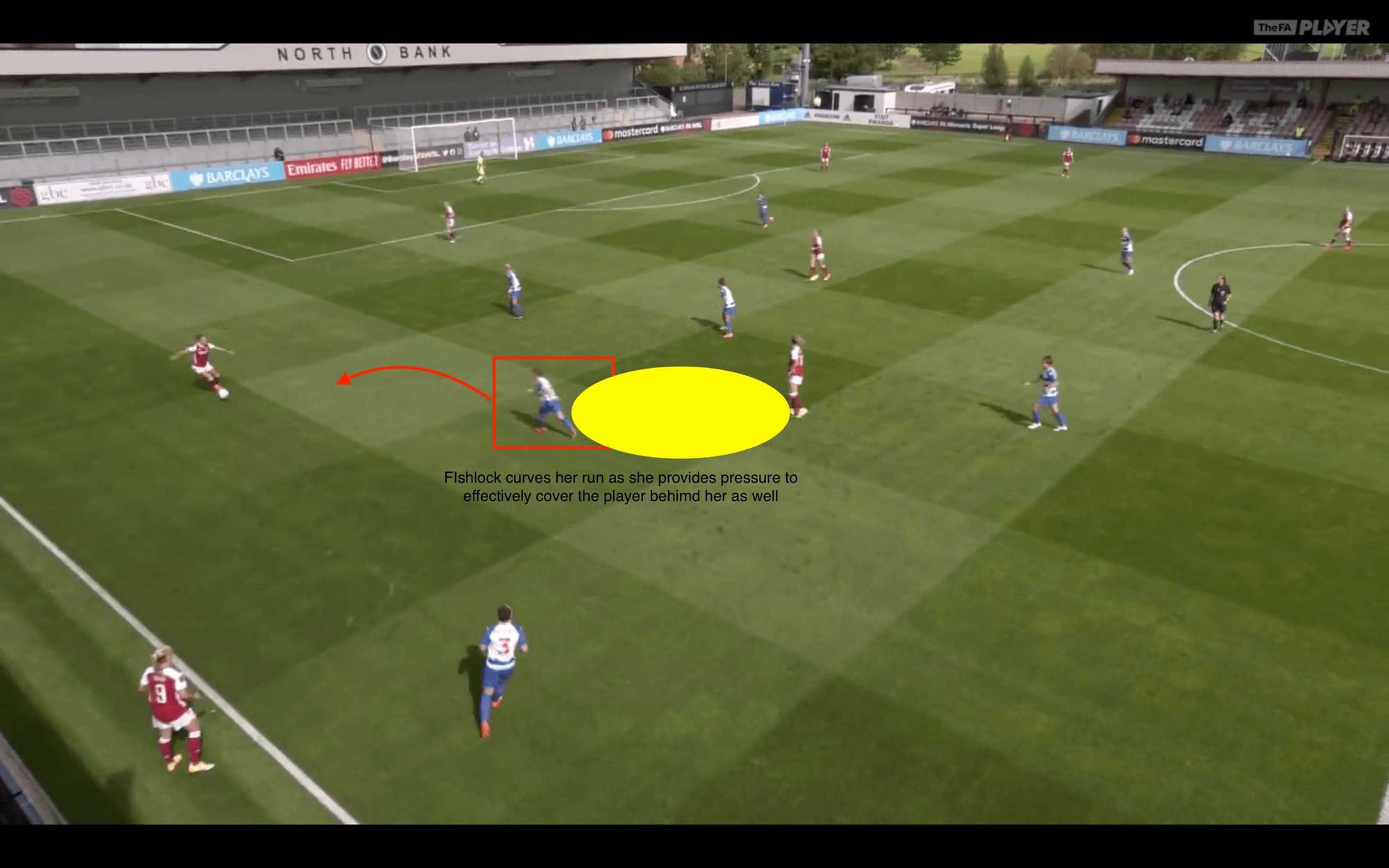
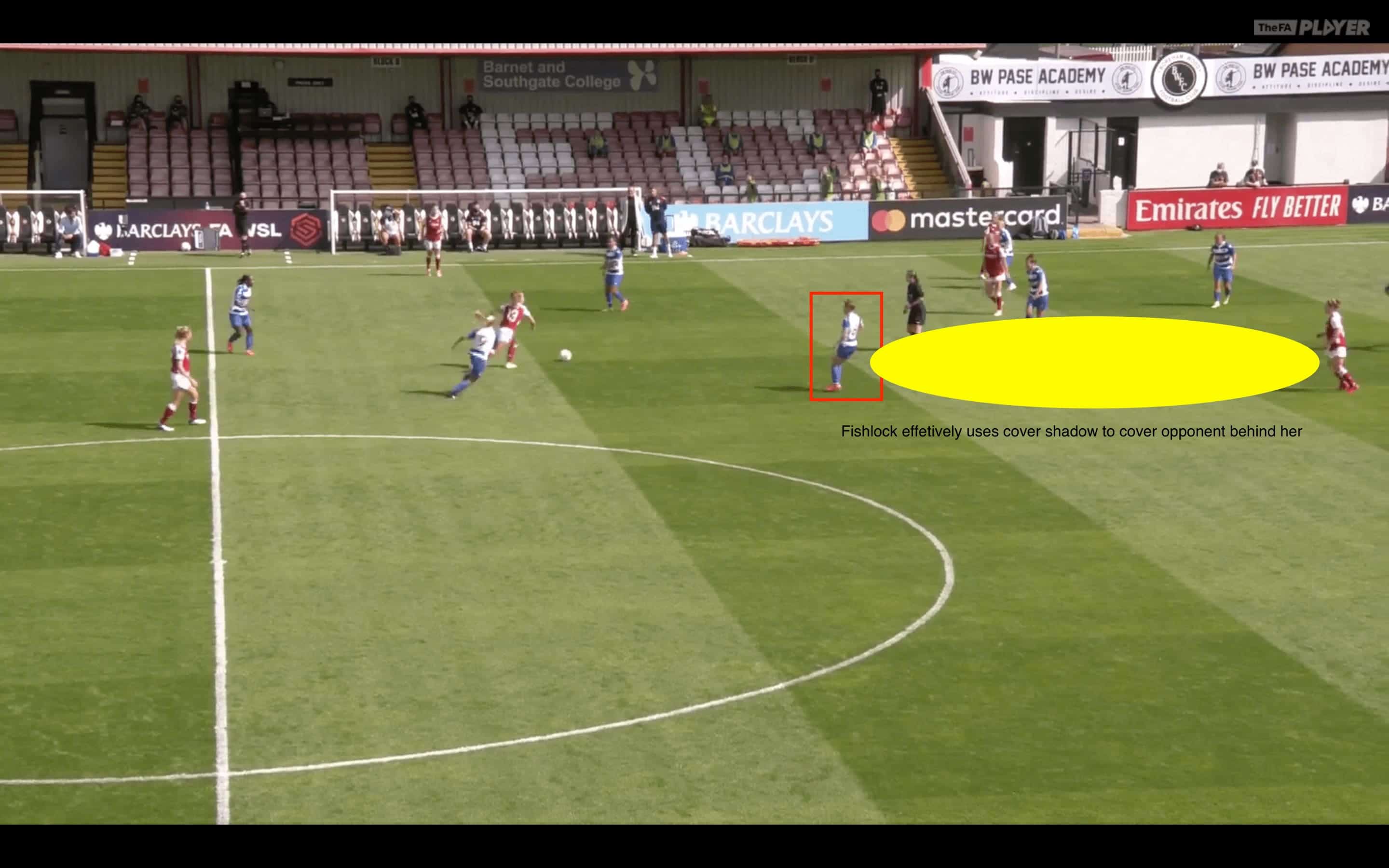
Fishlock’s ability to apply an effective cover shadow is incredibly impactful for the Reading tactical set up. Since Fishlock is effectively able to eliminate passing options behind her while applying pressure on the ball she greatly increases her defensive influence. By eliminating passing options behind her she allows her side to take a higher defensive line because they do not have to be concerned with players behind them. It also allows the Reading front three the chance to shift and apply pressure defensively, specifically on their opposition’s defence, as there are limited options for a forward pass available. By effectively using the cover shadow, Fishlock not only increases her defensive effectiveness, she enables her teammates to have a larger defensive presence as well.
Another benefit of an effective cover shadow is that it enables teams and players like Fishlock to be effectively set up to counter-attack their opposition. Since players are able to position themselves higher up the field, when Reading are able to win the ball, they have a greater number of players that are higher up the pitch, which enable them to add numbers into the attack quickly and effectively. This is incredibly useful for a team that aims to turn the ball over from their opposition often, as in theory it will create more opportunity to counter attack their opposition. Thus, Fishlock’s ability to provide an effective cover shadow not only helps her side in defence, but also enable them to be dangerous on the counter-attack.
In addition to her ability to provide a quality cover shadow, Fishlock also possesses the knowledge and ability to effectively cover for the Reading left-back at times. As shown below, when the Reading left-back gets pulled out of position, Fishlock is able to effectively cover that space and help limit attacking options behind the Reading left-back as well as limit the area that the Reading Center Backs are asked to cover.

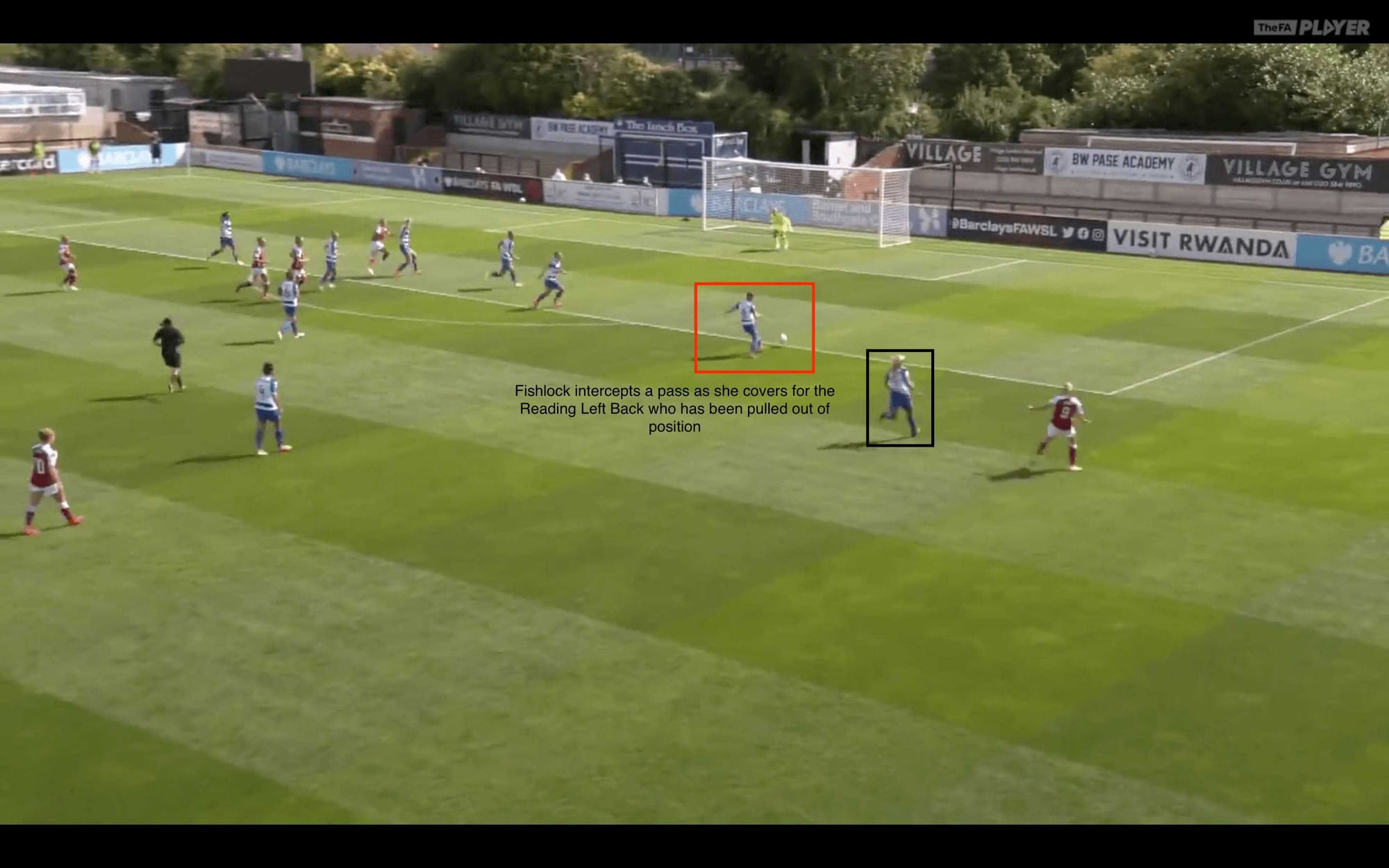
This is particularly important for a high pressing side like Reading. One of the key components of a high press is quickly and constantly applying pressure to the opposition player on the ball in an effort to win it back in an advantageous position. Since Fishlock has the knowledge and ability to provide defensive cover for the Reading left-back, said left-back has the freedom to apply pressure to the ball quickly and effectively, without being too concerned about the space in behind her.
In transition
As is often mentioned in today’s game, transitions moments are often the difference between winning and losing matches. Midfielders are often the catalysts in transition moments in the game and often help connect the defence to attack and vice versa. Fishlock is no exception to this and again, is excellent in a few ways that are very helpful in the modern game. Let’s examine her ability in these moments and what she is able to do to help her side.
As mentioned earlier, one of the most effective parts of Fishlock’s game is her effective cover shadow in defence. While being effective in defence, this also enables Fishlock to quickly join the attack once Reading has regained possession. We can see a few examples of this below.
As you can see, Fishlock’s defensive positioning often puts her in a position where she can quickly join the attack in transition. Reading are often looking to counter-attack when they win the ball as they often have numbers forward and space to attack. Thus, Fishlock’s movement is pretty linear in transition as she looks to join the attack and has the benefit of often being behind the play which enables her to read her frontline’s runs as she joins the attack, and then properly adjust to put herself in a dangerous area. Below is a good example of this.
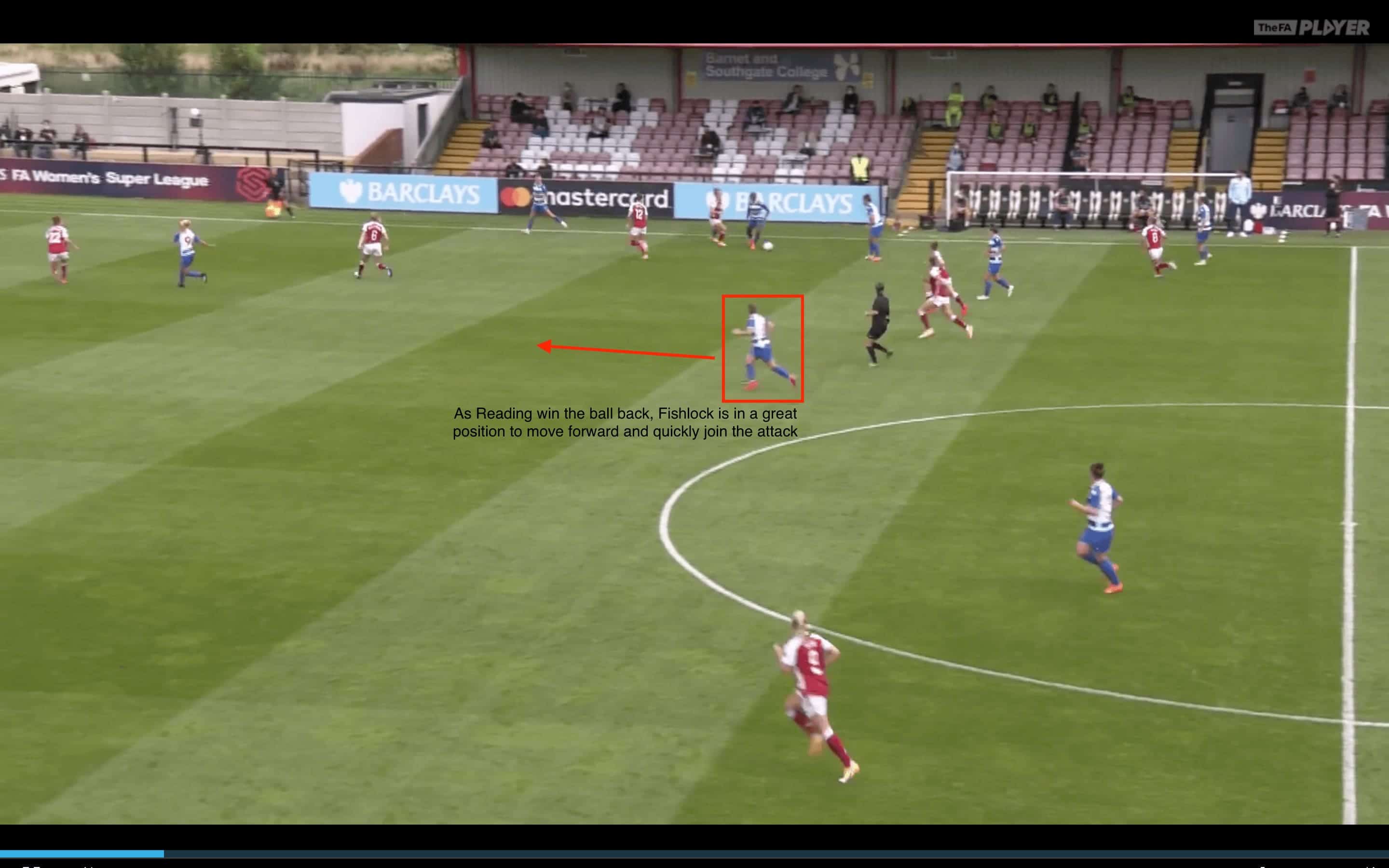
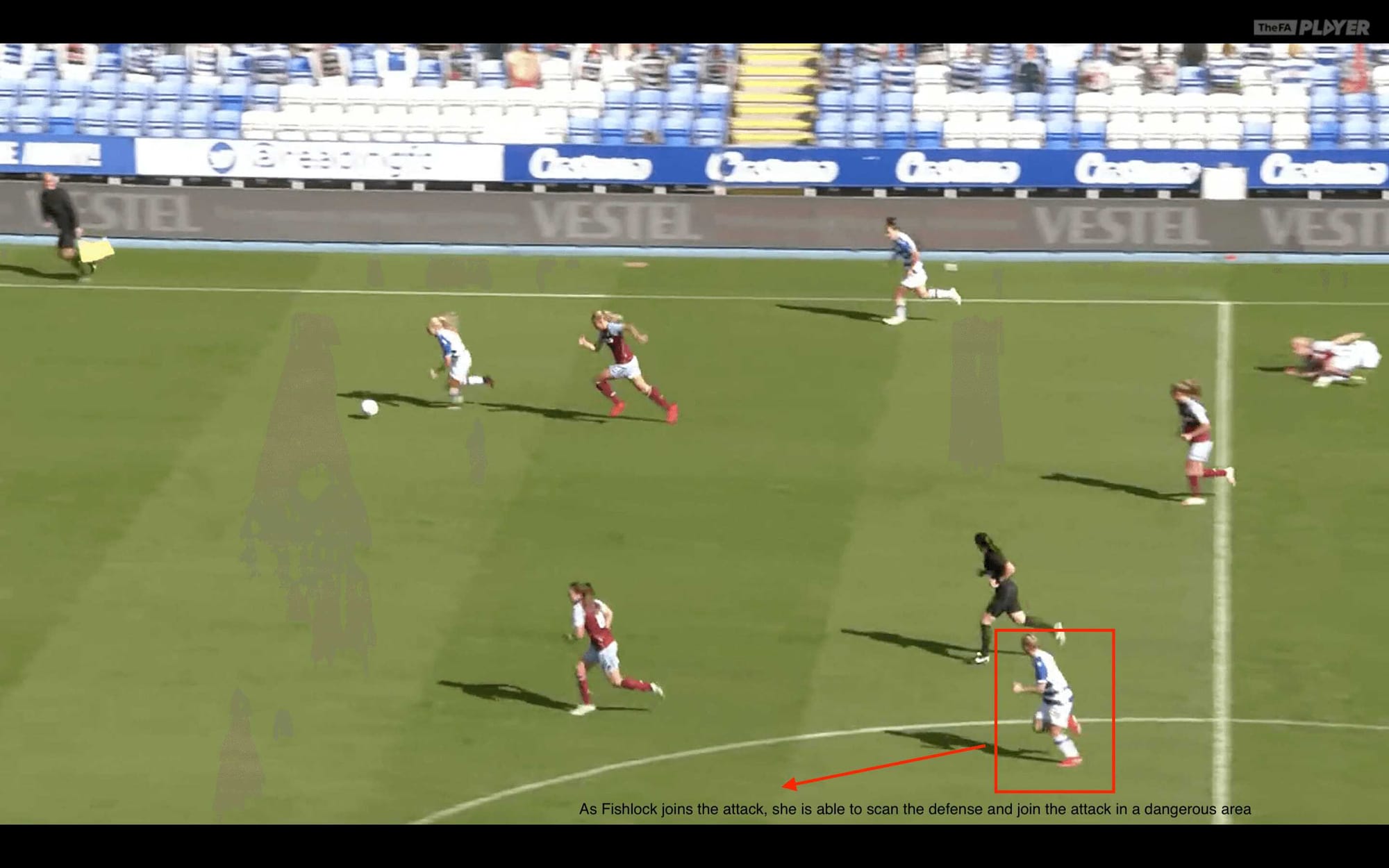
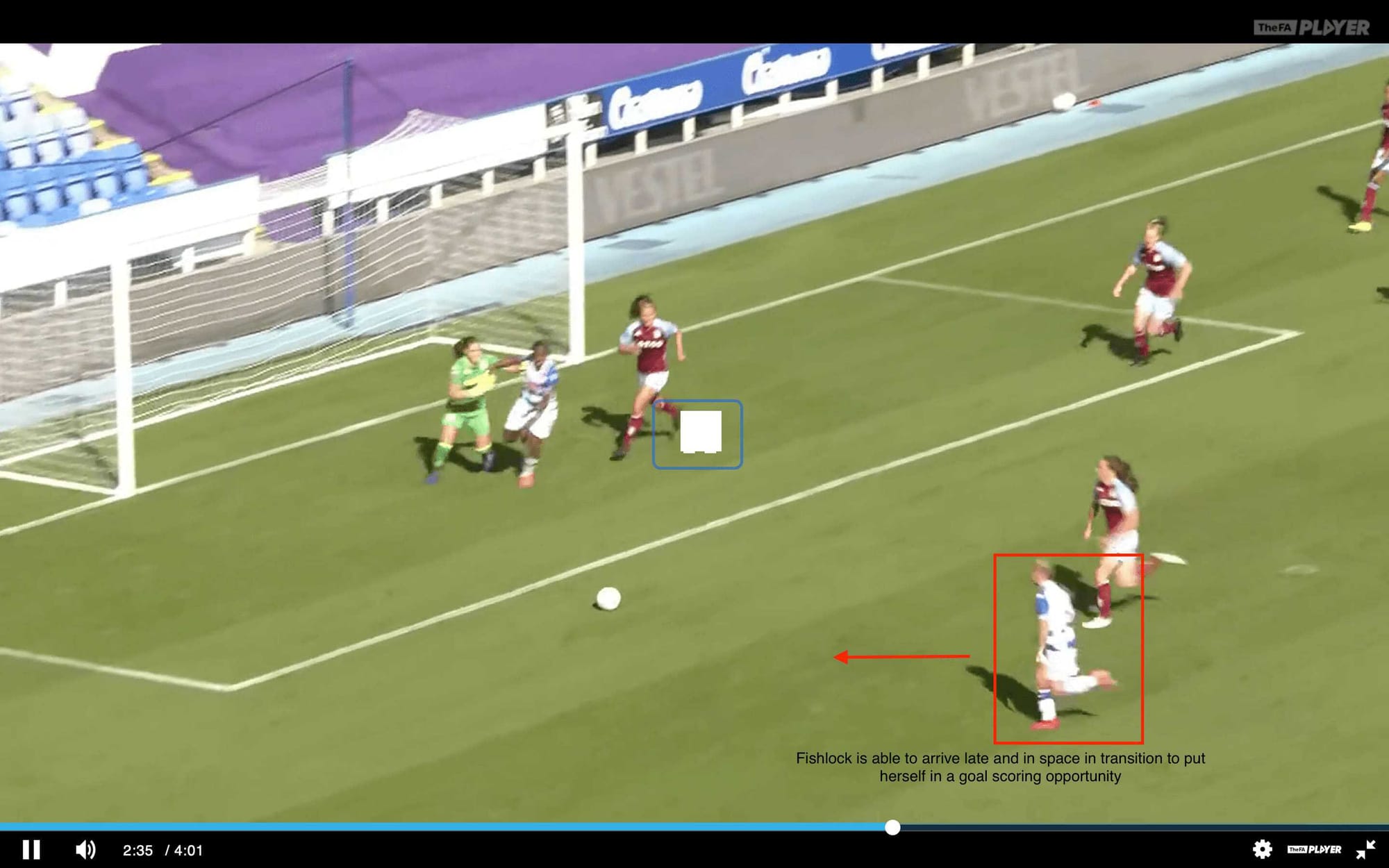
In addition to her ability to join the attack in transition, Fishlock is also solid in her defensive transitions. One of the things that Fishlock brings to the table is her ability to counterpress the opponent. Due to her role in the Reading attack, as well as her positional and spatial awareness, more often than not Fishlock is in or around the area that the ball is lost in. Thus, she is usually in a great position to counterpress the opponent, and does so effectively. Her counterpressing ability is very effective for her new teammates at Reading as it allows them to do two things integral to their tactical setup. Firstly, it enables either Fishlock or her teammates to win the ball back from the opposition quickly, thus enabling them to dominate possession often.
Likewise, and perhaps more importantly, it allows the rest of her side to recover into their defensive positions, specifically the Reading outside-backs. In possession, the outside-backs will push high up the pitch which has become commonplace for possession based sides in today’s game. Due to this, when Reading lose the ball, the outside backs typically have some ground to cover defensively before the opponents can exploit the empty space. Thus, when Fishlock is effectively able to apply pressure to the ball in a counterpress, she is giving her teammates time to recover. Even if she is unsuccessful in winning the ball, this feature of Fishlock’s defensive transition movement is hugely important to Reading’s tactical setup.
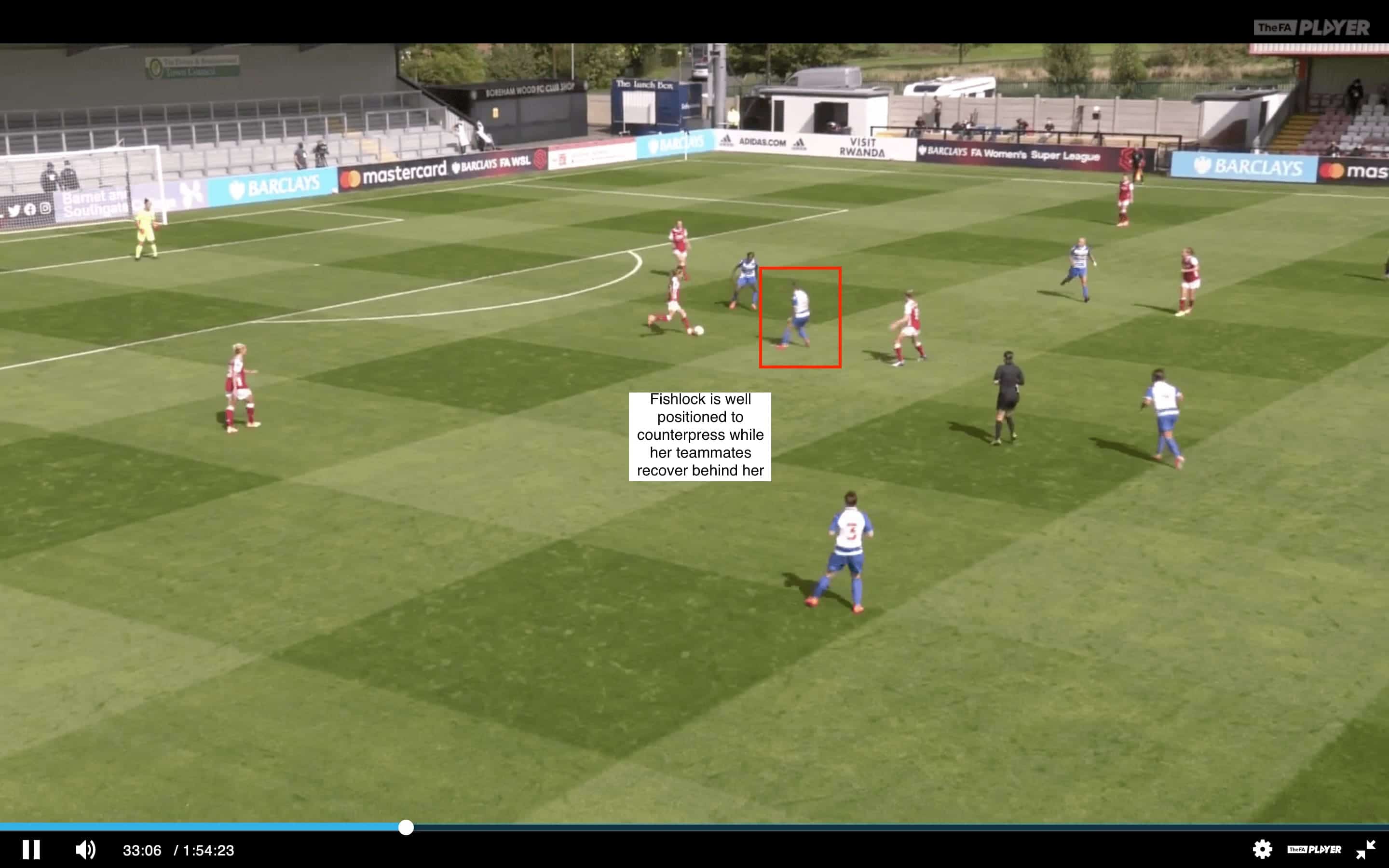
As you can see, Fishlock’s qualities are very beneficial for a team that sets up similarly to Reading. Add this to the vast amount of experience that Fishlock possesses and it is easy to see why this is such a good fit tactically for Reading and Fishlock.
Data analysis
Let’s take a look at some advanced data to determine how Fishlock is impacting Reading through their first two FAWSL matches and determine some strengths and weaknesses in her game thus far in the 2020/21 campaign.
As previously mentioned, Fishlock’s passing ability is often a characteristic that separates her from other players in her position and so far, the 20/21 campaign is no exception. At the time of writing, Fishlock finds herself in the top 10 in the FAWSL in both Passes into the Final Third as well as Key Passes (kp). She also finds herself leading Reading in these categories, proving that she is a vital part of Reading’s attack. In addition to this, Fishlock is leading all Reading players in Long Distance Passing Completion Percentage (passes longer than 25 yds.) who have attempted more than 10 long distance passes. This shows that not only is Fishlock an accurate long distance passer but she is often asked to do so in Reading’s build up phase as they look to circulate the ball to break their opposition’s defensive lines.
Fishlock is also an integral part of Reading’s defensive setup as we discussed previously. One illustration of this is her ability to apply pressure, often during a counterpress, and help her side regain the ball. Therefore, it is not surprising that Fishlock leads Reading in Successful Pressure Percentage (SP%), which calculates the percentage of time that Reading are able to regain possession of the ball within five seconds of Fishlock applying pressure to the opponent. It should be noted that this metric excludes players who have not applied pressure (defined as applying pressure to an opponent when they are receiving, carrying or releasing the ball) more than 10 times as that does not provide sufficient data to examine the effectiveness of a players ability to successfully apply pressure. Fishlock’s 22 successful pressures in 42 attempts finds her at a 52.4% SP%, which is good enough for 10th best in the FAWSL. Given Reading’s defensive structure and Fishlock’s defensive ability, this comes as no surprise.
For all of the obvious qualities in her game, as with any player, there is room for improvement for Fishlock. One of the most glaring weaknesses in her game is her shot accuracy and shot selection. So far in the 2020/21 campaign for Reading, Fishlock is yet to complete a shot on target (three shots, zero on target.) While this obviously a small sample size, this is a problem that has followed Fishlock so far in her career. In her most recent 30 games in the NWSL with OL Reign and thus far with Reading, Fishlock has attempted 77 shots while only 29 of these shots have been on target, for a meager 37% Shots on Target Percentage (Sot%) in the last 30 matches. Obviously, a player with her quality would like to have a higher percentage of shots on target to increase her effectiveness for her side. This glaringly low percentage is a reflection of Fishlock’s decision making in the final third. Oftentimes, Fishlock settles too easily for shots from difficult locations. Below is her shot locations map from her previous 30 matches.
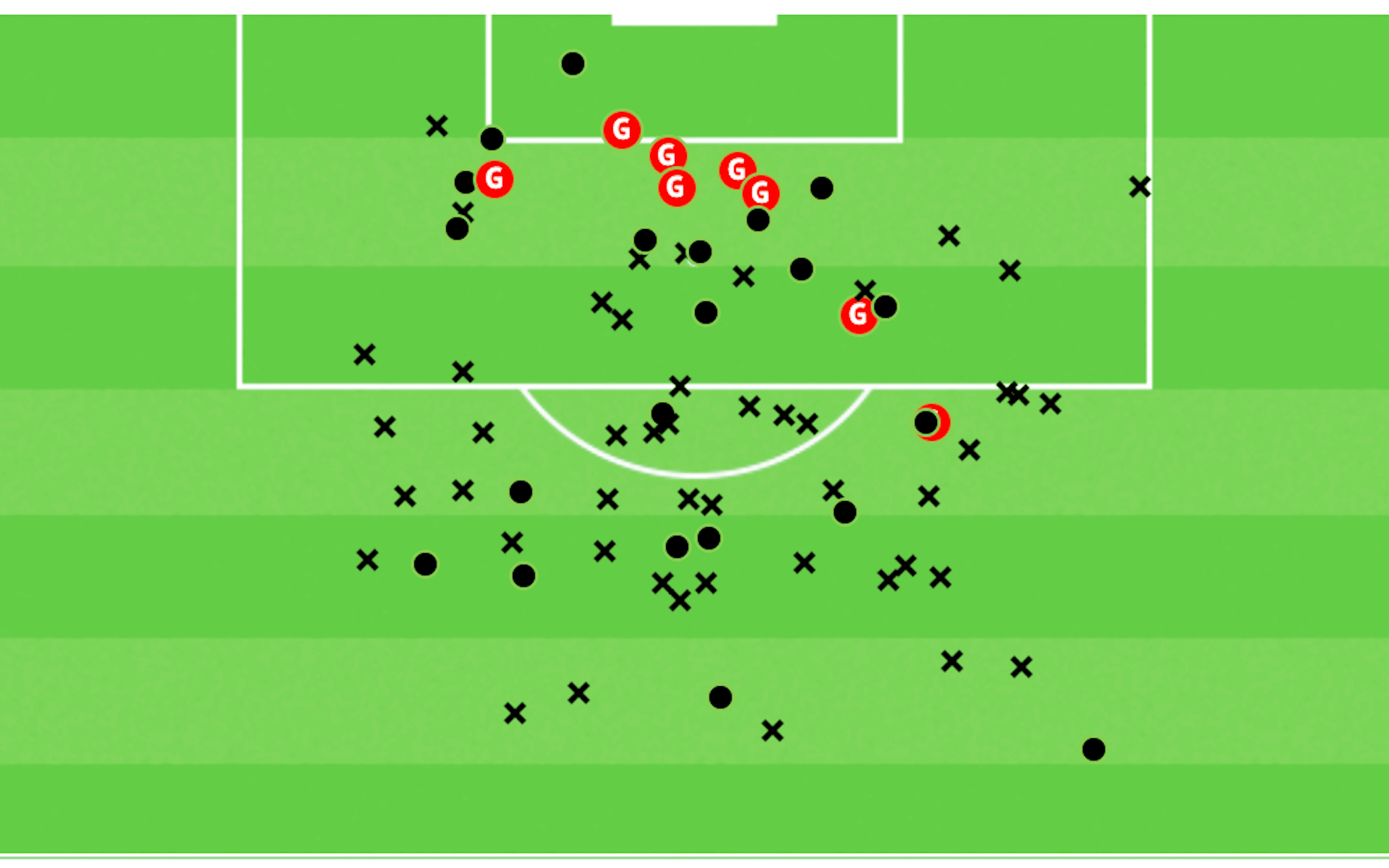
As you can see, the majority of Fishlock’s recent goals have come from the Gold Zone or the area of the field that is the width of the 6 yard box that extends from the goal line to the edge of the 18 yard box. From the shot location above you can see that Fishlock is much more accurate and effective shooting from this area as opposed to outside the 18 yard box. Despite this, the majority of Fishlock’s attempts are from outside of the Gold Zone.
Instead of shooting from less than ideal locations, Fishlock could instead look to connect passes to teammates in the final third who may be in better attacking positions or continue moving forward and attempt to get into better shooting positions herself. While Fishlock is a highly effective attacking player, making some subtle changes in her shot selection could be a massive step forward as her career continues to progress.
Conclusion
In conclusion, we have looked at the different aspects of Fishlock’s game and how they positively impact her new club Reading. Fishlock is an exceptional midfielder who does many things well including putting herself in great spaces to receive the ball and being one of the most dangerous passers for her side. We also explored the more underrated side of her game in defence. Not only is she effective providing a good cover shadow against her opposition, she also has an enhanced knowledge and recognition of moments to help cover the Reading left-back when the left-back is pulled out wide to defend. In addition to this, her recognition of opportunities to counterpress in defensive transition is outstanding.
Furthermore, her ability to recognise the attacking space available to her in transition is second to none. We also examined some advanced data to show her effectiveness in pressing her opponents. In addition to this, we looked at her shooting efficiency and examined why it may be a bit lower than average and how her decision making in the final third can be improved as she continues on in her career.






Comments